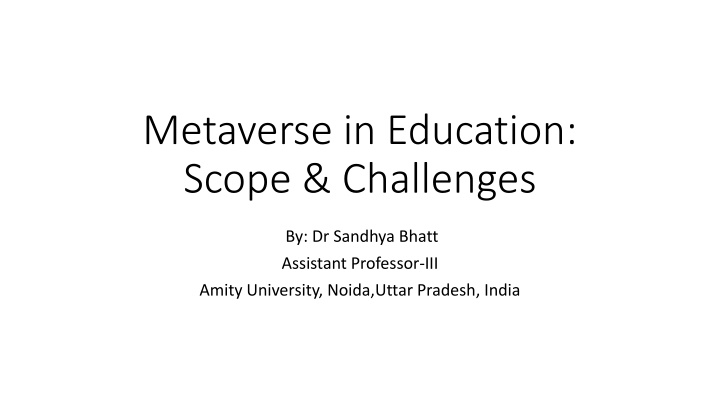
Exploring Metaverse in Education: Scope and Challenges
"Discover the potential of the Metaverse in revolutionizing education through immersive experiences, collaborative learning, and simulated scenarios. Learn about its key features, applications, and the need to address challenges for successful integration."
Download Presentation

Please find below an Image/Link to download the presentation.
The content on the website is provided AS IS for your information and personal use only. It may not be sold, licensed, or shared on other websites without obtaining consent from the author. If you encounter any issues during the download, it is possible that the publisher has removed the file from their server.
You are allowed to download the files provided on this website for personal or commercial use, subject to the condition that they are used lawfully. All files are the property of their respective owners.
The content on the website is provided AS IS for your information and personal use only. It may not be sold, licensed, or shared on other websites without obtaining consent from the author.
E N D
Presentation Transcript
Metaverse in Education: Scope & Challenges By: Dr Sandhya Bhatt Assistant Professor-III Amity University, Noida,Uttar Pradesh, India
INTRODUCTION o The metaverse, a term first introduced by Neal Stephenson in his 1992 science fiction novel Snow Crash, represents a convergence of virtual and augmented reality environments, creating a 3D digital space where users can interact in real-time with both the virtual world and each other. o The Metaverse is an interconnected virtual environment where users can interact through avatars in 3D spaces. It combines AR, VR, blockchain, and artificial intelligence (AI) to create shared, persistent virtual worlds. the metaverse is becoming a focal point of innovation across various sectors, including education (Zhang et al., 2022). o The educational Metaverse allows users to explore learning content, participate in simulations, attend virtual classrooms, and collaborate with peers and educators in real-time. o This paper examines the role of the Metaverse in modern education, its impact on student engagement, and how it can supplement traditional learning methods.
Purpose and Significance The metaverse allows for the simulation of real-world scenarios, the visualization of complex concepts, and the facilitation of collaborative learning experiences in ways that were previously unimaginable. For example, through immersive learning, students can explore historical events, conduct virtual experiments, and engage in problem-solving activities within a controlled, yet highly realistic, virtual environment (Meta, 2022). This chapter aims to explore the scope of the metaverse in education, examining both its potential applications and the challenges it presents. The goals of this chapter are threefold: to define the concept of the metaverse in the context of education, to discuss the current and potential applications of the metaverse in educational settings, and to identify the key challenges and considerations that must be addressed to effectively integrate the metaverse into the educational landscape. By doing so, this chapter seeks to provide a comprehensive understanding of how the metaverse can transform education and what needs to be done to ensure its successful implementation.
Key Features Virtual Reality (VR), Augmented Reality (AR), and Mixed Reality (MR): VR immerses users in a completely virtual environment, isolating them from the physical world. AR, on the other hand, overlays digital information onto the physical world, enhancing the user's perception of reality. MR combines elements of both VR and AR, allowing for interaction between real and virtual objects in real-time. These technologies are central to creating the immersive experiences that define the metaverse (Accenture, 2022; Park & Kim, 2022). o Digital Identities: In the metaverse, people are represented by avatars. This representation relates not only to the user's physical appearance, it also has symbolic meaning. Avatars are regarded as the digital, embodied versions of users. Avatars offer their users a vast number of possibilities, ranging from providing accurate representations of one's actual self, to providing more fantastic, or idealistic, representations. This plethora of options may allow users to meet their communication goals, for example, by conveying thought/ideas and/or serve different purposes, such as experimentation or the hiding of one's true identity to deceive others. (Barta et al., 2024) o Immersive Experiences: The metaverse offers highly immersive experiences that engage multiple senses and create a feeling of presence in the virtual environment. These experiences are made possible by the convergence of VR, AR, and MR technologies, which allow users to explore, interact, and manipulate digital objects and environments as if they were real. o
Metaverse in Educational Framework The metaverse demands a shift from traditional teacher-centered models to more student-centered, experiential learning approaches. In the metaverse, learning is highly interactive and often project-based, allowing students to engage deeply with content through simulations, role-playing, and collaborative projects. This approach aligns with constructivist theories of learning, which emphasize the importance of active participation in the learning process. Moreover, the use of AI within the metaverse can personalize learning experiences, adapting content and challenges to the individual needs of each student, thus enhancing both engagement and learning outcomes (Onu et al., 2024) . Assessment in the metaverse moves beyond traditional exams and quizzes. Instead, it incorporates real-time analytics and performance data gathered through students' interactions within the virtual environment. This data allows for continuous, formative assessment that provides immediate feedback, helping students to identify areas for improvement and adjust their learning strategies accordingly Frameworks for metaverse-based education typically adopt either hybrid or fully virtual models. Hybrid models blend physical classroom interactions with virtual experiences, enabling students to participate in learning activities both in-person and online. This approach is particularly beneficial in scenarios where flexibility is required, such as during global disruptions like the COVID-19 pandemic (Zhang et al., 2022).
Opportunities of the Metaverse in Education: Immersive Learning Experiences: The Metaverse can simulate real-world experiences, allowing students to "visit" historical sites, conduct experiments, explore complex scientific concepts, and more. o Virtual field trips, interactive historical reenactments, or simulations of mathematical and physical phenomena can provide deeper understanding. o Enhanced Collaboration: Virtual classrooms and meeting spaces allow students and educators to collaborate globally. It can bridge geographical barriers, creating a diverse and inclusive learning environment. o Real-time, interactive collaboration in virtual spaces encourages peer learning and communication. o Personalized Education: The Metaverse can adapt to individual learning styles and needs. Using AI and data analytics, it can offer tailored content and activities to enhance the student s experience. o Learning could be gamified, allowing students to progress through levels or challenges according to their mastery of subjects. o Access to a Wide Range of Resources: Students can access educational content from universities, companies, or research institutions worldwide. Digital twins, for instance, allow for the recreation of real-world phenomena, making it easier to study complex systems in a safe, controlled environment. o
Challenges of the Metaverse in Education: Technological and Infrastructure Barriers: Not all educational institutions have the resources to implement Metaverse technologies. Issues like high-speed internet access, VR hardware requirements, and software compatibility can limit widespread adoption. o The digital divide can exacerbate inequalities in access to education, particularly in low-income or rural areas. o Privacy and Security Concerns: The Metaverse raises significant questions about data privacy, as students interactions and behaviors in virtual spaces are tracked. The use of AI and blockchain technology can offer solutions, but the potential for misuse remains a concern. o Ensuring the safety and well-being of students in virtual environments is paramount, especially with younger users. o Psychological Effects: Prolonged use of virtual environments can cause issues such as eye strain, motion sickness, and disorientation. o The potential for escapism or an unhealthy attachment to virtual spaces could also hinder real-life social and cognitive development. o Pedagogical Shifts: The introduction of the Metaverse challenges traditional teaching methods and requires educators to adapt to new forms of content delivery. o Teachers must be trained to use these technologies effectively and ethically, which may require substantial investment in professional development. o
Future Prospects Integration with Artificial Intelligence: The future Metaverse could be deeply integrated with AI, enabling fully personalized learning experiences. AI could monitor student progress, provide real-time feedback, and adjust learning pathways to suit individual needs. o Blockchain for Credentialing: Blockchain technology may offer a way to authenticate academic achievements and certifications in the Metaverse, ensuring credibility and security in digital diplomas and certificates. o The Expansion of Social Learning: The Metaverse will likely become more social, integrating communities of learners and experts across disciplines. Collaborative learning in virtual worlds could enable students to participate in global research projects or interdisciplinary workshops. o
Conclusion: The Metaverse has the potential to revolutionize education by making learning more interactive, engaging, and accessible. However, there are significant challenges to overcome, particularly in terms of technology, equity, and the adaptability of educational systems. The ongoing research into the role of the Metaverse in education will continue to inform its integration into mainstream educational settings. As these virtual spaces evolve, they may offer more diverse, dynamic, and effective methods of teaching and learning.
References Steuer, J. (1992). Defining Virtual Reality: Dimensions Determining Telepresence. Journal of Communication. Jarmon, L., et al. (2009). The Role of Virtual Worlds in Education: Why Educators Should Look at Virtual Worlds. Educational Technology. Bower, M., et al. (2017). Augmented Reality in Education: Cases, Places, and Spaces. Educational Media International.





